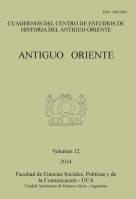Please use this identifier to cite or link to this item:
https://repositorio.uca.edu.ar/handle/123456789/6786| Título: | Recently discovered Iron Age lion figurines from Jerusalem Estatuillas de león de la Era de Hierro recientemente descubiertas provenientes de Jerusalén |
Autor: | Kletter, Raz Saarelainen, Katri Weksler-Bdolah, Shlomit |
Palabras clave: | HISTORIA ANTIGUA; EDAD DE HIERRO; EXCAVACIONES ARQUEOLOGICAS; OBJETOS ARQUEOLOGICOS | Fecha de publicación: | 2014 | Editorial: | Pontificia Universidad Católica Argentina. Facultad de Ciencias Sociales, Políticas y de la Comunicación. Centro de Estudios de Historia del Antiguo Oriente | Cita: | Kletter, R. Saarelainen, K. Weksler-Bdolah, S. Recently discovered Iron Age lion figurines from Jerusalem [en línea] Antiguo Oriente.Cuadernos del Centro de Estudios de Historia del Antiguo Oriente. 2014, 12 Disponible en: https://repositorio.uca.edu.ar/handle/123456789/6786 | Resumen: | Abstract: More than 500 Iron Age figurines were discovered in the 2005–2010 Western Wall Plaza excavations in Jerusalem.1 The excavations revealed a large building, probably of the four-room type. Many figurines were discovered in this building, others in fills below and above it, dating in general to the eighth-sixth centuries BCE. Here we focus on two heads most likely depicting lions, one of them exceptional—holding another animal in its mouth. We discuss the identification of these figurines as lions, the lion motif in a variety of media in the Southern Levant, and finally recent theories concerning lions in the Hebrew Bible and their relation to Yahweh. We suggest that the two Western Wall Plaza figurines represent lions as wild animals, in similarity to other figurines of wild animals made on occasion by Judean coroplasts. Resumen: Más de 500 estatuillas de la Edad del Hierro fueron descubiertas en las excavaciones de la Plaza del Muro Occidental de 2005–2010, en Jerusalén. Las excavaciones revelaron un gran edificio, probablemente del tipo de cuatro habitaciones. Se descubrieron muchas estatuillas en este edificio, otras en rellenos debajo y por encima de éste, datadas en general en los siglos VIII–VI a.C. Aquí nos focalizamos en dos cabezas que muy posiblemente representen leones, una de ellas excepcional—sosteniendo otro animal en su boca. Discutimos la identificación de estas estatuillas como leones, el motivo del león en una variedad de medios en el sur del Levante, y finalmente, teorías recientes concernientes a los leones en la Biblia Hebrea y su relación con Yavé. Sugerimos que las dos estatuillas de la Plaza del Muro Occidental representan leones como animales salvajes, de manera similar a otras estatuillas de animales salvajes realizadas en ocasiones por alfareros judaítas. |
Cobertura Espacial: | ISRAEL JERUSALEM |
URI: | https://repositorio.uca.edu.ar/handle/123456789/6786 | ISSN: | 1667-9202 | Disciplina: | ARQUEOLOGIA | Derechos: | Acceso Abierto | Fuente: | Antiguo Oriente. Cuadernos del Centro de Estudios de Historia del Antiguo Oriente. 2014, 12 |
| Appears in Collections: | AO - 2014 vol. 12 |
Files in This Item:
| File | Description | Size | Format | |
|---|---|---|---|---|
| recently-discovered-iron-age-jerusalem.pdf | 912,05 kB | Adobe PDF |  View/Open |
Page view(s)
144
checked on Apr 30, 2024
Download(s)
99
checked on Apr 30, 2024
Google ScholarTM
Check
This item is licensed under a Creative Commons License

